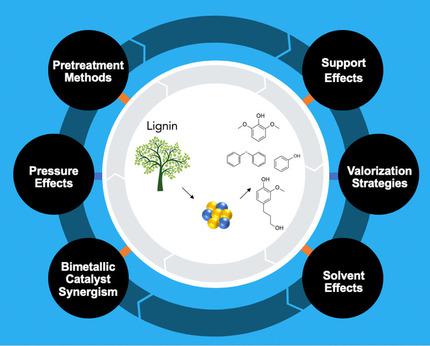当前位置:
X-MOL 学术
›
ChemSusChem
›
论文详情
Our official English website, www.x-mol.net, welcomes your
feedback! (Note: you will need to create a separate account there.)
Heterogeneous Catalyst Design Principles for the Conversion of Lignin into High-Value Commodity Fuels and Chemicals.
ChemSusChem ( IF 7.5 ) Pub Date : 2020-03-24 , DOI: 10.1002/cssc.202000002 Mark Gale 1 , Charles M Cai 2, 3 , Kandis Leslie Gilliard-Abdul-Aziz 1, 4
ChemSusChem ( IF 7.5 ) Pub Date : 2020-03-24 , DOI: 10.1002/cssc.202000002 Mark Gale 1 , Charles M Cai 2, 3 , Kandis Leslie Gilliard-Abdul-Aziz 1, 4
Affiliation

|
Lignin valorization has risen as a promising pathway to supplant the use of petrochemicals for chemical commodities and fuels. However, the challenges of separating and breaking down lignin from lignocellulosic biomass are the primary barriers to success. Integrated biorefinery systems that incorporate both homo- and heterogeneous catalysis for the upgrading of lignin intermediates have emerged as a viable solution. Homogeneous catalysis can perform selected chemistries, such as the hydrolysis and dehydration of ester or ether bonds, that are more suitable for the pretreatment and fractionation of biomass. Heterogeneous catalysis, however, offers a tunable platform for the conversion of extracted lignin into chemicals, fuels, and materials. Tremendous effort has been invested in elucidating the necessary factors for the valorization of lignin by using heterogeneous catalysts, with efforts to explore more robust methods to drive down costs. Current progress in lignin conversion has fostered numerous advances, but understanding the key catalyst design principles is important for advancing the field. This Minireview aims to provide a summary on the fundamental design principles for the selective conversion of lignin by using heterogeneous catalysts, including the pairing of catalyst metals, supports, and solvents. The review puts a particular focus on the use of bimetallic catalysts on porous supports as a strategy for the selective conversion of lignin. Finally, future research on the valorization of lignin is proposed on the basis of recent progress.
中文翻译:

木质素转化为高价商品燃料和化学品的非均相催化剂设计原理。
木质素的价格上涨已成为一种替代石油化学产品用于化学商品和燃料的有前途的途径。然而,从木质纤维素生物质中分离和分解木质素的挑战是成功的主要障碍。结合了均相和异相催化以升级木质素中间体的集成生物精炼系统已成为一种可行的解决方案。均相催化可以执行选定的化学方法,例如酯或醚键的水解和脱水,它们更适合生物质的预处理和分馏。但是,非均相催化为将提取的木质素转化为化学品,燃料和材料提供了可调平台。为了通过使用更均一的催化剂来降低成本的方法,已经进行了大量的努力来阐明使用多相催化剂来木质素增值的必要因素。木质素转化的当前进展促进了许多进步,但是了解关键的催化剂设计原理对于推进该领域很重要。本Minireview旨在概述使用多相催化剂(包括催化剂金属,载体和溶剂的配对)选择性转化木质素的基本设计原理。该综述特别关注在多孔载体上使用双金属催化剂作为木质素选择性转化的策略。最后,根据最近的进展,提出了木质素增值的未来研究。努力探索更强大的方法来降低成本。木质素转化的当前进展促进了许多进步,但是了解关键的催化剂设计原理对于推进该领域很重要。本Minireview旨在概述使用多相催化剂(包括催化剂金属,载体和溶剂的配对)选择性转化木质素的基本设计原理。该综述特别关注在多孔载体上使用双金属催化剂作为木质素选择性转化的策略。最后,根据最近的进展,提出了木质素增值的未来研究。努力探索更强大的方法来降低成本。木质素转化的当前进展促进了许多进步,但是了解关键的催化剂设计原理对于推进该领域很重要。本Minireview旨在概述使用多相催化剂(包括催化剂金属,载体和溶剂的配对)选择性转化木质素的基本设计原理。该综述特别关注在多孔载体上使用双金属催化剂作为木质素选择性转化的策略。最后,根据最近的进展,提出了木质素增值的未来研究。但是了解关键的催化剂设计原则对于推进该领域很重要。本Minireview旨在概述使用多相催化剂(包括催化剂金属,载体和溶剂的配对)选择性转化木质素的基本设计原理。该综述特别关注在多孔载体上使用双金属催化剂作为木质素选择性转化的策略。最后,根据最近的进展,提出了木质素增值的未来研究。但是了解关键的催化剂设计原则对于推进该领域很重要。本Minireview旨在概述使用多相催化剂(包括催化剂金属,载体和溶剂的配对)选择性转化木质素的基本设计原理。该综述特别关注在多孔载体上使用双金属催化剂作为木质素选择性转化的策略。最后,根据最近的进展,提出了木质素增值的未来研究。该综述特别关注在多孔载体上使用双金属催化剂作为木质素选择性转化的策略。最后,根据最近的进展,提出了木质素增值的未来研究。该综述特别关注在多孔载体上使用双金属催化剂作为木质素选择性转化的策略。最后,根据最近的进展,提出了木质素增值的未来研究。
更新日期:2020-04-22
中文翻译:

木质素转化为高价商品燃料和化学品的非均相催化剂设计原理。
木质素的价格上涨已成为一种替代石油化学产品用于化学商品和燃料的有前途的途径。然而,从木质纤维素生物质中分离和分解木质素的挑战是成功的主要障碍。结合了均相和异相催化以升级木质素中间体的集成生物精炼系统已成为一种可行的解决方案。均相催化可以执行选定的化学方法,例如酯或醚键的水解和脱水,它们更适合生物质的预处理和分馏。但是,非均相催化为将提取的木质素转化为化学品,燃料和材料提供了可调平台。为了通过使用更均一的催化剂来降低成本的方法,已经进行了大量的努力来阐明使用多相催化剂来木质素增值的必要因素。木质素转化的当前进展促进了许多进步,但是了解关键的催化剂设计原理对于推进该领域很重要。本Minireview旨在概述使用多相催化剂(包括催化剂金属,载体和溶剂的配对)选择性转化木质素的基本设计原理。该综述特别关注在多孔载体上使用双金属催化剂作为木质素选择性转化的策略。最后,根据最近的进展,提出了木质素增值的未来研究。努力探索更强大的方法来降低成本。木质素转化的当前进展促进了许多进步,但是了解关键的催化剂设计原理对于推进该领域很重要。本Minireview旨在概述使用多相催化剂(包括催化剂金属,载体和溶剂的配对)选择性转化木质素的基本设计原理。该综述特别关注在多孔载体上使用双金属催化剂作为木质素选择性转化的策略。最后,根据最近的进展,提出了木质素增值的未来研究。努力探索更强大的方法来降低成本。木质素转化的当前进展促进了许多进步,但是了解关键的催化剂设计原理对于推进该领域很重要。本Minireview旨在概述使用多相催化剂(包括催化剂金属,载体和溶剂的配对)选择性转化木质素的基本设计原理。该综述特别关注在多孔载体上使用双金属催化剂作为木质素选择性转化的策略。最后,根据最近的进展,提出了木质素增值的未来研究。但是了解关键的催化剂设计原则对于推进该领域很重要。本Minireview旨在概述使用多相催化剂(包括催化剂金属,载体和溶剂的配对)选择性转化木质素的基本设计原理。该综述特别关注在多孔载体上使用双金属催化剂作为木质素选择性转化的策略。最后,根据最近的进展,提出了木质素增值的未来研究。但是了解关键的催化剂设计原则对于推进该领域很重要。本Minireview旨在概述使用多相催化剂(包括催化剂金属,载体和溶剂的配对)选择性转化木质素的基本设计原理。该综述特别关注在多孔载体上使用双金属催化剂作为木质素选择性转化的策略。最后,根据最近的进展,提出了木质素增值的未来研究。该综述特别关注在多孔载体上使用双金属催化剂作为木质素选择性转化的策略。最后,根据最近的进展,提出了木质素增值的未来研究。该综述特别关注在多孔载体上使用双金属催化剂作为木质素选择性转化的策略。最后,根据最近的进展,提出了木质素增值的未来研究。











































 京公网安备 11010802027423号
京公网安备 11010802027423号